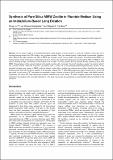Por favor, use este identificador para citar o enlazar a este item:
http://hdl.handle.net/10261/200459COMPARTIR / EXPORTAR:
 SHARE SHARE
 CORE
BASE CORE
BASE
|
|
| Visualizar otros formatos: MARC | Dublin Core | RDF | ORE | MODS | METS | DIDL | DATACITE | |

| Título: | Synthesis of Pure Silica MWW Zeolite in Fluoride Medium by Using an Imidazolium-Based Long Dication |
Autor: | Lu, Peng; Gómez-Hortigüela Sainz, Luis CSIC ORCID ; Camblor, Miguel Ángel CSIC ORCID | Palabras clave: | Zeolite synthesis Zeolites Density functional calculations Fluoride media Molecular mechanics Structure directing agent MWW zeolite Structure-direction Molecular mechanics DFT calculation |
Fecha de publicación: | 2019 | Editor: | John Wiley & Sons | Citación: | Chemistry - A European Journal 25: 1561- 1572 (2019) | Resumen: | [EN] As the spacer length in 1,2-dimethylimidazolium-based dications increases beyond a specific point (six methylene units), they fail in structure-directing towards STW zeolites in any synthetic conditions. These dications can instead produce, under fluoride concentrated conditions, either *BEA [in the case of the eight-methylene-unit structure-directing agent (SDA)] or MWW (ten methylene units) zeolites. For any length of the dication, the default zeolite (MTW) is a relatively dense zeolite containing a unidimensional channel, whereas the zeolite demanding most specificity (STW, *BEA or MWW) is more porous, affording a larger concentration of the dication to be occluded. This work provides the first reported fluoride synthesis of pure silica MWW zeolites. Charge balance of the organic dications in this zeolite was achieved by combining “structural” silanolates, regular “connectivity defects” and occluded fluoride. Molecular mechanics calculations showed a perfect fit of the decamethylenebis(dimethylimidazolium) dication in the sinusoidal intralayer pore system of MWW. The calculations showed also that the dication is able to stabilize the interlayer space without disturbing the hydrogen-bonding system that holds the layers together in the as-made material. The F magic-angle spinning (MAS) NMR presented two distinct resonances at −71 and −83 ppm, which, on the basis of DFT calculations, we tentatively assigned to fluoride occluded in [46] and [456] cages of the MWW structure, respectively. The same DFT study determines a different chemical shift of one methyl C nuclear magnetic resonance according to the imidazolium ring residing in the sinusoidal channels or in the large cup cavities, thus explaining an experimentally observed splitting of that resonance. | Versión del editor: | http://dx.doi.org/10.1002/chem.201804973 | URI: | http://hdl.handle.net/10261/200459 | DOI: | 10.1002/chem.201804973 | Identificadores: | doi: 10.1002/chem.201804973 e-issn: 1521-3765 issn: 0947-6539 |
| Aparece en las colecciones: | (ICMM) Artículos (ICP) Artículos |
Ficheros en este ítem:
| Fichero | Descripción | Tamaño | Formato | |
|---|---|---|---|---|
| Lu_Synthesis_Chem_European_Journal_2019_posprint.pdf | 3,12 MB | Adobe PDF |  Visualizar/Abrir |
CORE Recommender
SCOPUSTM
Citations
14
checked on 29-abr-2024
WEB OF SCIENCETM
Citations
13
checked on 28-feb-2024
Page view(s)
194
checked on 30-abr-2024
Download(s)
264
checked on 30-abr-2024
Google ScholarTM
Check
Altmetric
Altmetric
NOTA: Los ítems de Digital.CSIC están protegidos por copyright, con todos los derechos reservados, a menos que se indique lo contrario.
